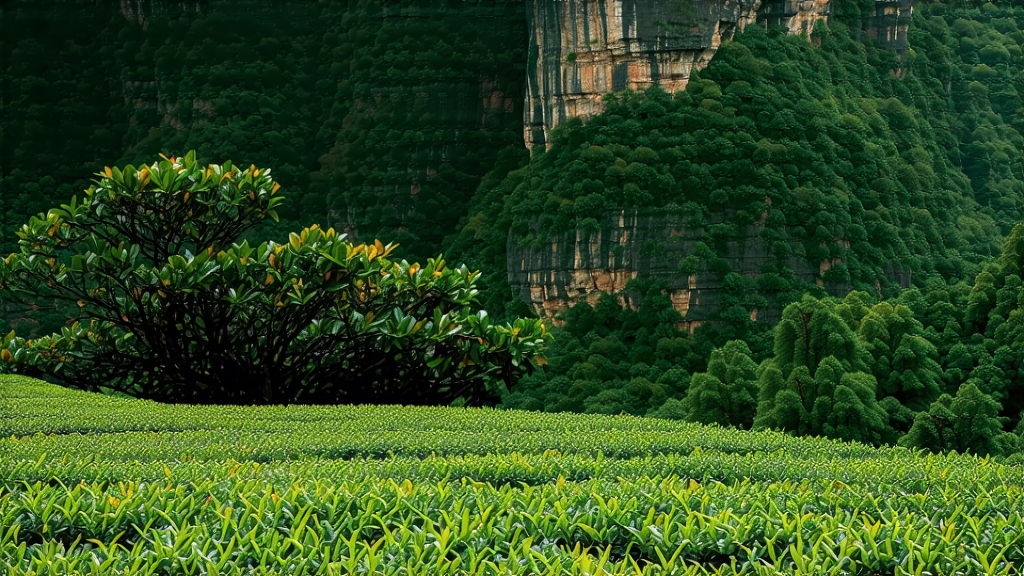
If green tea is the fresh-faced scholar of Chinese teas and pu-erh the bearded sage, then Da Hong Pao—literally “Big Red Robe”—is the battle-scarred monarch who rules from the vertiginous cliffs of northern Fujian’s Wuyi Mountains. For four centuries this rock oolong (yancha) has fascinated emperors, poets, and now global sommeliers with its paradoxical profile: a liquor that smells of midnight orchards yet tastes of wet stones and roasted nuts, a leaf that can endure a dozen infusions while still revealing new faces. This article walks international readers through the legend, the landscape, the craft, and the cup, offering practical guidance on how to brew, taste, and appreciate the most mythologized oolong on earth.
-
Origin story: from imperial scarlet to auction stardom
The name first appears in Ming-dynasty county records: a scholar hurrying to the capital fell ill on Wuyi’s Nine-Dragon Bend; monks brewed leaves plucked from nearby bushes, restored him overnight, and the grateful candidate later returned in a crimson robe to drape the bushes in thanks. Whether apocryphal or not, the tale cemented the tea’s prestige. By the Qing era only six mother trees perched on Tianxin Rock were deemed authentic; their yearly yield—barely 200 g—was reserved for the Forbidden City. In 2002 just 20 g of that “imperial mother-tree” Da Hong Pao sold at auction for 180 000 yuan (then US $28 000), catapulting the tea into global headlines and prompting Fujian authorities to graft cuttings onto lower-elevation gardens. Today “pure” Da Hong Pao is a genetic descendant of those clones, while “blended” versions marry selected Wuyi cultivars (typically Qi Dan, Bei Dou, and Que She) to recreate the mother-tree flavor spectrum. -
Terroir: why “rock” matters
UNESCO lists the 60-km Wuyi gorge as a World Heritage biosphere; its narrow ravines trap morning mist, creating 80 % humidity even at noon, while volcanic tuff cliffs reflect infrared heat back onto the bushes at dusk. The soil is a mineral slurry of weathered granite and quartz; roots must dive half a meter through fissures for water, concentrating polyphenols and aromatic precursors. Locals insist that only leaf plucked within the 60 km² core scenic zone deserves the name zhengyan (“true cliff”); outside that radius the same cultivar becomes banyan (“half-cliff”) or zhoucha (“peripheral”), losing the signature yan yun—“rock rhyme,” a tactile finish reminiscent of licking wet slate. -
Cultivar family: three brothers under one red robe
Although “Da Hong Pao” functions as a brand, three related cultivars dominate the blend recipe.- Qi Dan (“strange red”)—the closest genetic match to the mother trees, small-leaf, slow-growing, high in geraniol, giving lavender top notes.
- Bei Dou (“north star”)—developed in 1985 from cuttings taken at 800 m, hardier, with a peppery mid-palate.
- Que She (“sparrow tongue”)—tiny leaves shaped like a bird’s beak, prized for lingering molasses sweetness. Master blenders roast each cultivar separately, then marry them in ratios guarded like perfume formulas, aiming for a tri-layered cup: floral attack, mineral spine, honey tail.
-
Craft: the sixteen-hour odyssey from cliff to cup
Plucking happens only in late April when leaves have “opened three-quarters” and the spring mist lifts just enough to let the sun kiss the edges. Two-and-a-half leaves plus the bud are snapped with a twist that breaks internal veins but keeps the stem intact—critical for even oxidation. After three hours of sun-withering, the leaf is shaken in 1.2 m diameter bamboo drums for bruising; this “green shaking” (yaoqing) is repeated five times at 90-minute intervals, each round gentler than the last, coaxing enzymes to convert catechins into theaflavins without fermentation going fully black. Oxidation is arrested at 30 % by a 280 °C tumble in electric woks for eight minutes; the leaf emerges jade at the center, burgundy at the rim. Next comes